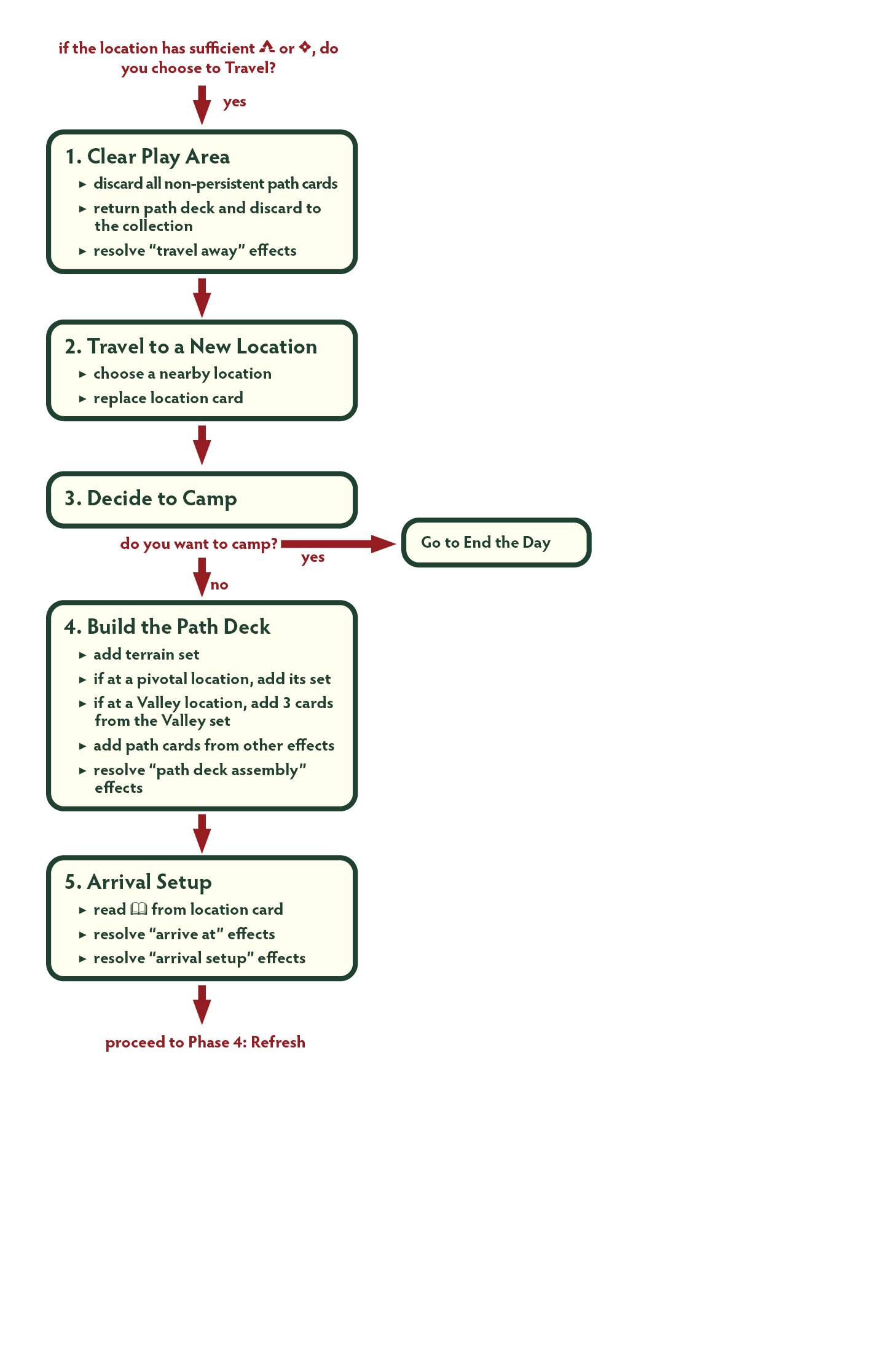Travel
Traveling is how you move around the Valley, visit new locations, discover people and places unique to certain areas.
You can choose travel during Phase 3: Travel if you have exceeding the progress threshold of the location, or components such as the campaign guide or path cards can instruct you to travel immediately.
When you travel, perform the following steps:
1. Clear Play Area
Discard all path cards in play and all Ranger cards within reach, along the way , or in the surroundings (but not in your player area). Then sort all cards from the path deck and path discard into their sets, and return them to your collection .
Note: Cards with the persistent keyword are not discarded.
Missions that instruct you to “travel away” from a location resolve at this time.
2. Travel to a new location
As a group, choose a new location to travel to by consulting the Valley map You must choose a nearby location - one that is connected directly to your current location by one of the paths marked on the map. The chosen destination must be the next location on the chosen path (you cannot “skip” over a location).
Once the group has chosen a destination, find its location card, and place it into the surroundings, replacing the current location.
Note: You cannot travel along river paths until a certain game component allows you to do so.
3. Decide to Camp
After choosing your new location, as a group, you can decide to end the day and set up camp for the night before venturing into the new landscape. Ending the day in this way is safer than ending it in the middle of navigating through a location and allows you an opportunity to prepare yourselves for the next day.
If you end the day in this way, you are allowed to swap reward cards into your Ranger decks between sessions (see customizing ranger decks). If you chose not to end the day, continue to step 4.
4. Build the Path Deck
To build the path deck for your new location, combine several sets of path cards:
- Terrain Set: The locations in the Valley can be vast areas, and the path you take can dramatically change your experience of them. The terrain you travel across determines what kinds of features and wildlife you will encounter.
Each path on the Valley map has an associated type of terrain based on its color and an icon that appears along the line. To form the base of the path deck, find all path cards from the set matching the type of terrain of the path you took to the new location. - Location Set: Certain locations have notable people and places to seek out or discover on your journey. These locations are pivotal. This is listed on their card and is marked on the Valley map with a gold and brown eight-pointed star. These locations have sets of path cards unique to them. Add each of these cards to the path deck.
If your new location is not pivotal, you are never quite sure who or what you’ll encounter. You might find one of the Valley’s other wanderers, other features of the Valley, or an exceptionally dangerous predator. Shuffle all the path cards in The Valley set, and add three random cards from this set to the path deck. - Other Path Cards: Other game effects may add additional cards to the path deck.
Check the weather, location, and missions for any instructions labeled “Path Deck Assembly.” When you finish building the path deck, shuffle it.
5. Arrival Setup
Read the campaign guide entry noted on the back of the location card.
Missions to “arrive at” a location resolve now. These may override reading the normal campaign guide entry.
To finish setting up your destination, resolve each instruction under the “Arrival Setup” header. Most cards instruct the lead Ranger to resolve an effect then have some number of “next Rangers” resolve effects. If an effect calls for the “next Ranger,” but each Ranger has already resolved an effect, ignore those additional effects.
Travel Flowchart
